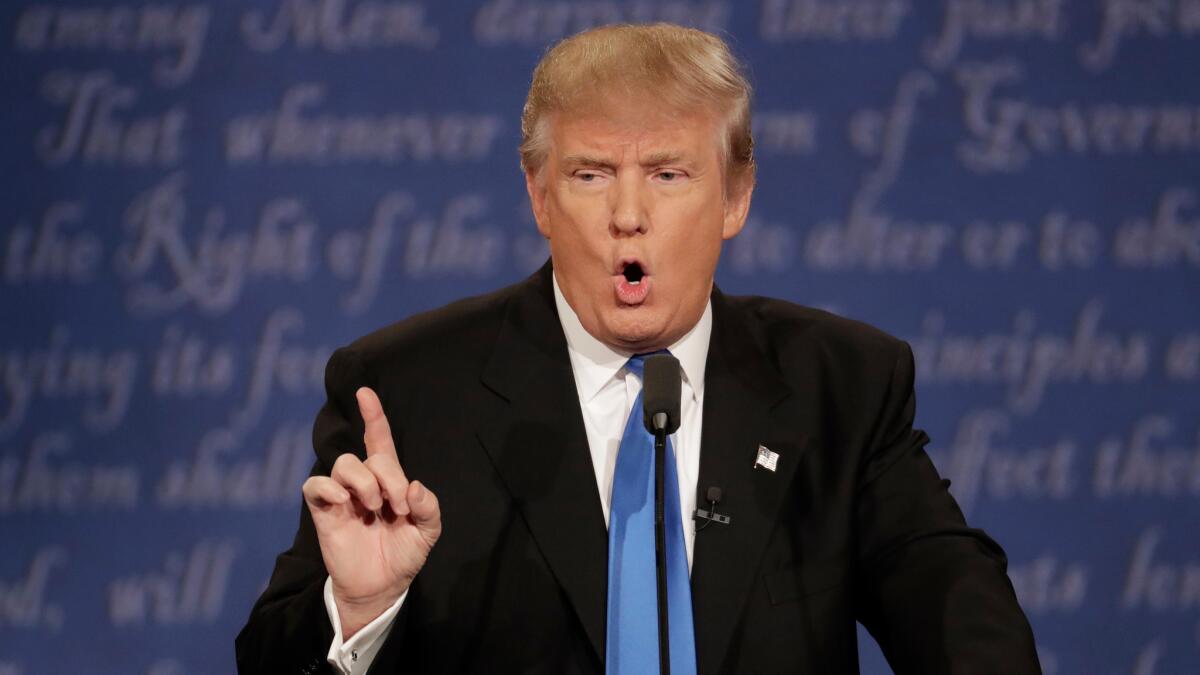Op-Ed: If Trump starts a trade war, California could lose 640,000 jobs

- Share via
Los Angeles would be the worst affected county in America, losing 176,000 jobs by 2019, if Donald Trump is elected president and fulfills his campaign pledge to unleash trade wars with China and Mexico. Another 60,000 jobs would be lost in Orange County. California as a whole could see 640,000 jobs disappear, more than 4% of private sector employment. And this is just a small taste of what might happen nationally—according to a Peterson Institute model for a scenario in which the U.S. imposes a 45% tariff on China and a 35% tariff on Mexico, and they respond in kind.
Trade issues have seldom reached the top of the U.S. political agenda. For decades, a consensus in favor of an open U.S.-led trade system held. But the 2016 election has marked a departure from this pattern. Both major candidates oppose the Trans-Pacific Partnership, the single major trade initiative under consideration. This opposition is regrettable: TPP would deliver significant gains to the U.S. economy, and its failure would be a blow to both the U.S. economy and U.S. standing in Asia.
But Trump goes much further than Hillary Clinton, promising punitive tariffs on China and Mexico, at times advocating firm-specific tariffs (which are historically unprecedented and probably unconstitutional), talking about abrogating “disastrous” free trade agreements, and even considering withdrawing from the World Trade Organization. That last move, if implemented, could undo 70 years of economic diplomacy.
The last time the U.S. enacted protectionist trade policies, cutting itself off from the rest of the world, that action worsened the Great Depression.
The sobering reality is that legal experts believe that under a variety of statutes, the president has considerable executive authority to do these things. Even if Trump were ultimately stymied by Congress or the courts, that process would be time-consuming, giving him ample opportunity to wreak havoc.
Capital goods industries would be hardest hit. The trade shock would then propagate throughout the economy, also destroying jobs in sectors such as retail, restaurants, and temporary employment agencies. Millions of jobs that appear unconnected to international trade—many of them filled by lower-skilled and lower-wage workers—would be at risk.
The Peterson Institute forecast—which used conventional economic models based on national income, employment and other macroeconomic variables, as well as models capturing the linkages among more than 300 sectors down to the county level—indicates that the worst year would be 2019. At that point, the economy would slowly begin recovering from the shock. Hiring would subsequently pick up, but there is no guarantee that displaced workers would be re-employed at their previous pay levels.
Washington state would be hardest hit, experiencing a loss of private sector employment of more than 5%. However, a broad array of states, including a number of so-called battleground states, would suffer employment declines of more than 4%. In California, the job losses would not be limited to Southern California: Silicon Valley would take a major hit, with Santa Clara County losing 64,000 jobs, or more than 7% of private employment, for example.
China and Mexico might decide to retaliate in ways other than imposing tariffs, but even in scenarios in which retaliation is limited, Southern California could be hurt. For instance, if China were to instruct its state-owned enterprises to stop buying U.S. business services, the state could lose nearly 14,000 jobs, with nearly 6,000 of those losses occurring in Los Angeles and Orange counties alone. The state and region would experience additional losses if China decided to stop buying U.S. aircraft.
There’s a reason liberalizing international trade has been the policy of the United States for the last 70 years. The last time the U.S. enacted protectionist trade policies, cutting itself off from the rest of the world, that action worsened the Great Depression. While Clinton’s opposition to the TPP will cost America potential income gains and will undermine U.S. leadership in Asia, Trump’s proposals could actually sink the U.S. economy. Clinton’s policies amount to a fender bender. Trump’s would be a head-on collision.
When asked about trade wars, Trump once insouciantly replied, “Who the hell cares?” In these trade wars, the American causalities will be numerous and disproportionately drawn from the ranks of lower-income citizens.
Marcus Noland is executive vice president and director of studies at the Peterson Institute for International Economics, and senior fellow at the East-West Center.
Follow the Opinion section on Twitter @latimesopinion or Facebook
More to Read
A cure for the common opinion
Get thought-provoking perspectives with our weekly newsletter.
You may occasionally receive promotional content from the Los Angeles Times.










